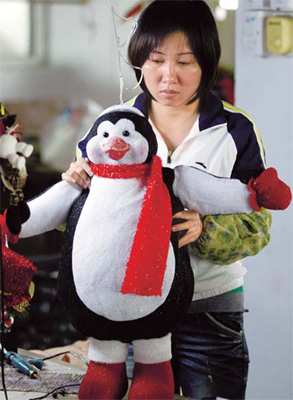Focus
Little Christmas cheer for factories
By Gao Qihui (China Daily)
Updated: 2010-12-24 07:49
 |
Large Medium Small |
|
|
Rising expenses
Profit margins for factories making Christmas products are already paper-thin, ranging from just 2 to 5 percent, according to a recent report by Xinhua News Agency that quoted an unnamed expert with the Chinese Chamber of Commerce for Imports and Exports of Light Industrial Products and Arts and Crafts.
Things have only been made worse by sharp rises in the cost of labor and raw materials.
Take non-woven fabric, the most common material used in festive ornaments and dolls, prices soared from about 8,000 yuan a ton in January to more than 16,000 yuan a ton in October.
"With raw materials making up at least 40 percent of our gross costs, I dare not purchase any non-woven fabric right now. I'm waiting for the price to drop," said Huang, whose company has been producing yuletide ornaments for 18 years.
Many traders are instead looking to buy from manufacturers in East China's Zhejiang province, where supplies are cheaper.
"We're now less competitive, as Shantou is not a source of raw materials," complained Chen Shaoyan, owner of Zheng Chang Long Carton Factory, which has been making yuletide ornaments for 10 years.
However, even in Zhejiang, the so-called "home of fabrics", plants have witnessed staggering price hikes for core ingredients in their products.
"Our gross costs have increased by about 25 percent," said Huang Jili, general manager of Orient Crafts in Ningbo, a city on the province's east coast. "We are feeling the same pressures."
Although the price of raw materials is likely to fall, analysts predict companies will have to deal with labor shortages and rising salary demands for some time to come.
Factories across the Yangtze River and Pearl River deltas - China's two economic powerhouses - have been short on hands since March this year, following the national Spring Festival holidays.
In response, at least 14 provinces and municipalities have raised the minimum wage, including both Guangdong and Zhejiang.
"If my production line is running at full capacity, we need at least 800 workers," said Chen in Shantou. "This year, I had only 200 workers during the peak time."
He said the situation forced his company to reject several orders from clients, resulting in sales falling 30 percent.
"Some manufacturers finished the orders at a loss to maintain the operation and keep their workers," added Chen.
Luo Yonghuang, deputy general manager of Hongfeng Arts and Crafts in Meizhou, Guangdong, complained that even though he raised his workers' wages by 150 percent, the company still experienced a labor shortage.
As most Christmas products are assembled by hand, the industry is extremely reliant on human resources, and a shift toward mechanized operations would be economically unfeasible for most.
Currency changes
If labor and material costs were not enough, the appreciation of the yuan against the United States dollar may be the straw that breaks the back of China's Christmas product manufacturers.
"If the exchange rate appreciates two or three points, I may not accept any orders at all," said Chen.
Huang Shaokuang at Jiaying Arts and Crafts also urged the central government to curb currency appreciation for fear that "exporters may lose confidence to continue in this business".
Frustrated, manufacturers are trying to take control of their own destiny.
To save on costs, Jiaying is planning to use more "economical materials" in its factory, rather than top-class ingredients. It will also make product designs simpler to cut down on labor.
Like other companies, Huang Shaokuang said his is prepared to raise the prices of its products by at least 15 percent in 2011. Quotations will be reset after March in case the yuan appreciates too much, he added.
However, as Chinese manufacturers are low on bargaining power due to the fierce competition, experts say they will eventually have to compromise with foreign buyers.
To improve profits, Yi Xiaozhun, vice-minister of commerce, urged export-oriented factories to innovate with product design and function, as well as increase added value.
Producers of Christmas handicrafts, big and small, have heeded the call and are investing millions into creating new, standout products.
"I spend at least 1 million on developing new designs every year, which has accounted for 5 percent of our total spending some years," said Chen in Shantou.
As Christmas decorations, ornaments and dolls are seasonal, production lines run for only half a year. The rest of the time, most manufacturers are concentrating on designing and producing samples.
However, handicrafts are easily copied and often pirated by traders who attempt to pass off manufacturers' designs as their own. This is not helped by the fact that, for small and medium-sized firms, buying patents for products can be too expensive.
"Only if we get an order of more than $50,000 for a new product will we apply for a patent," said Huang Shaokuang.
Chen complained that, in most cases, manufacturers are paying for the innovation, but not benefiting from it.
